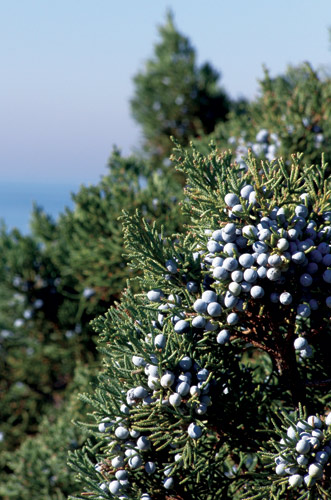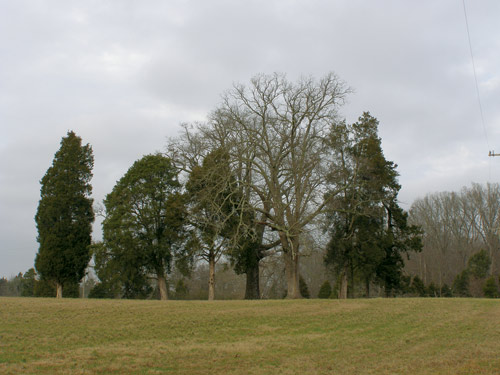A tale of two cedars
Originally published January 8, 2009

The bluish berries and scale-like leaves of this coastal red cedar are very similar to the berries and leaves of the common eastern red cedar. Photo by Ken Moore.
By Ken Moore
It was the driest of years and the wettest of years. North Carolina’s two red cedars stood strong and green during the year of drought and rains.
The eastern red cedar, Juniperus virginiana, surrounds us in the Piedmont. Except for the outer coastal regions and the high mountain elevations, the eastern cedar tree is common throughout the eastern U.S., extending into Texas and northward up through the Midwestern states. It is adapted to a wide range of soil types, moisture regimes and temperature extremes. It grows in all but water-logged soils.
It is an early successional tree species – one of the first to appear on abandoned farmland and other disturbed sites. Birds disperse the seed, accounting for characteristic rows of cedar along fence lines and beneath power line perches. On good soils, cedars can be shaded out if competing with a dense stand of pines and they are slowly displaced by maturing deciduous forests. Cedars do require sunlight. In contrast, on really shallow soils and on xeric (extremely dry) sites, cedars compete well and can mature as a dominate tree of the plant community.
Occasionally, you will notice a dense stand of red cedars growing so thickly that other tree species have great difficulty gaining a foothold. Such cedar stands persist for decades.
Eastern red cedars grow upright, but their shapes are consistently variable. Commonly, they have steeple-like tops on elongated egg-shaped bodies, punctuating rural landscapes like giant evergreen exclamation marks. You may have observed unusual pencil-thin specimens along roadways between High Point and Lexington, looking like cedars on a diet. And scattered about there are giant old specimens with tops flattened out with age.
In contrast is the coastal or southern red cedar, Juniperus silicicola, (considered only a variety by current taxonomists), which grows on the outer coastal plain south to Florida. It is really out there, found on the exposed sand dunes, sculpted by winds and salt spray into twisted, horizontal, bonsai-like configurations. Even in sheltered sites, this coastal variety displays a habit that is broader than tall, unlike its inland cousin.
I would like to grow one of these picturesque coastal cedars in my landscape; but though there are numerous cultivars of the eastern red cedar available in nurseries, I’ve never found cultivars of the coastal variety. I’ve always wondered if the coastal cedar would grow straight and tall away from that challenging ocean-side environment.
Native Americans considered cedars sacred above all trees. The evergreeness; the pink-colored, aromatic, rot-resistant wood; and the medicinal qualities of the berries and leaves are just a few of the merits that native people revered. Smoke from burning green and dried leaves and twigs was important in ceremonies, inhaled to relieve numerous internal ailments, and even believed effective in driving away malevolent spirits that could not endure the smell. The wood itself was too sacred to be used as fuel.
You are fortunate if you have a cedar or two already in your landscape. The bluish berries on the female trees are a favorite food of cedar waxwings and other birds and the dense foliage provides important nesting and roosting cover during all seasons. Simply seeing green accents of red cedars in the winter landscapes makes for a warm feeling.

Coastal red cedar never attains the height of the eastern red cedar. Photo by Ken Moore.



Comments are closed.